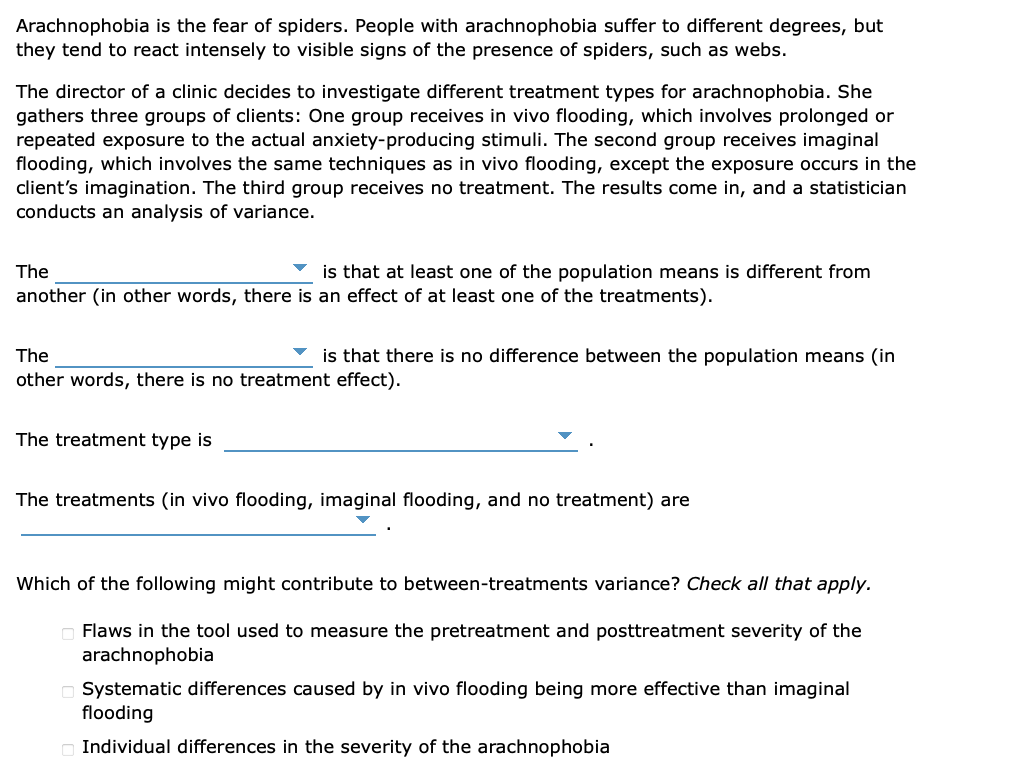The is that at least one of the population means is different from another (in other words, there is an effect of at least one of the treatments). The is that there is no difference between the population means (in other words, there is no treatment effect). The treatment type is The treatments (in vivo flooding, imaginal flooding, and no treatment) are Which of the following might contribute to between-treatments variance? Check all that apply.
The is that at least one of the population means is different from another (in other words, there is an effect of at least one of the treatments). The is that there is no difference between the population means (in other words, there is no treatment effect). The treatment type is The treatments (in vivo flooding, imaginal flooding, and no treatment) are Which of the following might contribute to between-treatments variance? Check all that apply.
Algebra & Trigonometry with Analytic Geometry
13th Edition
ISBN:9781133382119
Author:Swokowski
Publisher:Swokowski
Chapter10: Sequences, Series, And Probability
Section10.8: Probability
Problem 29E
Related questions
Question
100%
problem #2

Transcribed Image Text:Arachnophobia is the fear of spiders. People with arachnophobia suffer to different degrees, but
they tend to react intensely to visible signs of the presence of spiders, such as webs.
The director of a clinic decides to investigate different treatment types for arachnophobia. She
gathers three groups of clients: One group receives in vivo flooding, which involves prolonged or
repeated exposure to the actual anxiety-producing stimuli. The second group receives imaginal
flooding, which involves the same techniques as in vivo flooding, except the exposure occurs in the
client's imagination. The third group receives no treatment. The results come in, and a statistician
conducts an analysis of variance.
The
is that at least one of the population means is different from
another (in other words, there is an effect of at least one of the treatments).
The
is that there is no difference between the population means (in
other words, there is no treatment effect).
The treatment type is
The treatments (in vivo flooding, imaginal flooding, and no treatment) are
Which of the following might contribute to between-treatments variance? Check all that apply.
Flaws in the tool used to measure the pretreatment and posttreatment severity of the
arachnophobia
Systematic differences caused by in vivo flooding being more effective than imaginal
flooding
Individual differences in the severity of the arachnophobia
Expert Solution
This question has been solved!
Explore an expertly crafted, step-by-step solution for a thorough understanding of key concepts.
This is a popular solution!
Trending now
This is a popular solution!
Step by step
Solved in 2 steps

Recommended textbooks for you

Algebra & Trigonometry with Analytic Geometry
Algebra
ISBN:
9781133382119
Author:
Swokowski
Publisher:
Cengage

Algebra & Trigonometry with Analytic Geometry
Algebra
ISBN:
9781133382119
Author:
Swokowski
Publisher:
Cengage